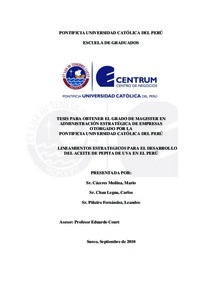| dc.contributor.advisor | Del Carpio Castro, Luis Alfonso | |
| dc.contributor.author | Cáceres Medina, Mario | |
| dc.contributor.author | Chau Legua, Carlos | |
| dc.contributor.author | Piñeiro Fernández, Leandro | |
| dc.date.accessioned | 2019-02-11T23:12:05Z | |
| dc.date.available | 2019-02-11T23:12:05Z | |
| dc.date.created | 2010-09 | |
| dc.date.issued | 2019-02-11 | |
| dc.identifier.uri | http://hdl.handle.net/20.500.12404/13471 | |
| dc.description.abstract | El objetivo de estudio es realizar un análisis de la industria del aceite y
proponer lineamientos estratégicos que permitan desarrollar la industria del aceite
de pepita de uva en el Perú, aprovechando los residuos de la industria vitivinícola
y del pisco.
El aceite de pepita de uva es un producto que actualmente no es producido
en el Perú, sin embargo, debido a sus propiedades benéficas para el consumo
humano y su apreciable sabor en la gastronomía, hace que el producto sea
considerado como un aceite premium, donde un sector de la población reconoce y
prefiere esta clase de ventajas.
Debido al crecimiento económico del Perú en los últimos años, hay más
peruanos que se encuentran en la capacidad de poder escoger productos que
otorguen beneficios a la salud. Es por esta razón que otros aceites premium se han
establecido con éxito, siendo sus principales consumidores los del nivel
socioeconómico A y B.
El crecimiento de la industria vitivinícola y del pisco ha ido de la mano
con el crecimiento económico del Perú. Los residuos de estas industrias, que no
presenta ningún uso, pueden ser utilizados como materia prima en la elaboración
del aceite de pepita de uva. Este punto es una ventaja frente a los demás tipos de
aceites, pues hay una gran disponibilidad de la materia prima, que es uno de los
factores claves para el desarrollo de esta industria.
Como resultado de nuestro estudio, se concluye que la industria del aceite
de pepita de uva tendría oportunidad para el ingreso en el mercado, debiendo
posicionarse en los sectores socioeconómicos A y B como un aceite premium. Sin embargo, la industria deberá establecerse cerca de las zonas vitivinícolas y
pisqueras para obtener el volumen adecuado de materia prima que permita una
producción del aceite de pepita de uva que satisfaga la demanda. | es_ES |
| dc.description.abstract | The objective of this study is to analyze the oil industry and propose
strategic guidelines to develop the grape seed oil industry in Peru, taking
advantage of remains from the Wine and Pisco industries.
The grape seed oil is a product that is not currently produced in Peru,
however, because of its beneficial properties for human consumption and its great
taste in food, makes the product to be considered a premium oil, where a sector of
the population recognizes and prefers this kind of advantage.
Due to Peru's economic growth in recent years, most Peruvians have the
ability to choose beneficial products for health. It is for this reason that other
premium oils have been successfully established, being its main consumers those
of the socioeconomic level A and B.
The growth of the wine and pisco industries has been going at the same
speed of the economic growth in Peru. The remains from these industries, which
have no use, can be used as raw material for the production of grape seed oil. This
is an advantage over other kinds of oils, as there is a large availability of raw
material, which is one of the key factors for the development of this industry.
As a result of our investigation, we’ve concluded that the grape seed oil
industry would have the opportunity to enter the market and it must be positioned
in both socioeconomic level A and B, as a premium oil. However, the industry
must be established near the wine and pisco areas in order to obtain an appropriate
amount of raw material that allows a production of grape seed oil that meets the
demand. | es_ES |
| dc.language.iso | spa | es_ES |
| dc.publisher | Pontificia Universidad Católica del Perú | es_ES |
| dc.rights | info:eu-repo/semantics/openAccess | es_ES |
| dc.rights.uri | http://creativecommons.org/licenses/by-nc-nd/2.5/pe/ | * |
| dc.subject | Uvas--Industria y comercio--Perú | es_ES |
| dc.subject | Frutas--Industria y comercio--Perú | es_ES |
| dc.subject | Planificación estratégica | es_ES |
| dc.title | Lineamientos estratégicos para el desarrollo del aceite de pepita de uva en el Perú | es_ES |
| dc.type | info:eu-repo/semantics/masterThesis | es_ES |
| thesis.degree.name | Maestro en Administración Estratégica de Empresas | es_ES |
| thesis.degree.level | Maestría | es_ES |
| thesis.degree.grantor | Pontificia Universidad Católica del Perú. CENTRUM | es_ES |
| thesis.degree.discipline | Administración Estratégica de Empresas | es_ES |
| renati.advisor.dni | 07535773 | |
| renati.advisor.orcid | https://orcid.org/0000-0001-9084-1193 | es_ES |
| renati.author.dni | 09812471 | |
| renati.author.dni | 40137101 | |
| renati.author.dni | 10867899 | |
| renati.discipline | 413307 | es_ES |
| renati.level | https://purl.org/pe-repo/renati/level#maestro | es_ES |
| renati.type | https://purl.org/pe-repo/renati/type#tesis | es_ES |
| dc.publisher.country | PE | es_ES |
| dc.subject.ocde | https://purl.org/pe-repo/ocde/ford#5.02.04 | es_ES |






